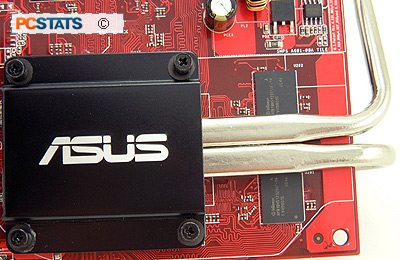The Radeon X1600 XT core contains 157 million transistors,
and a good portion of those circuits are dedicated to the task of rendering 12
pixel and 5 vertex pipelines. The memory controller is 256 bits in width. To
save on power, the EAX1600XT Silent core supports dynamic voltage control as
well.
 While the Asus EAX1600XT
Silent/TVD/256M/A is technically ATI CrossFire compatible, to take advantage of
this you'll need CrossFire friendly motherboard and a master
Radeon X1600 videocard to pair it with. Given that neither of these criteria are
especially abundant, it's almost a moot feature.
While the Asus EAX1600XT
Silent/TVD/256M/A is technically ATI CrossFire compatible, to take advantage of
this you'll need CrossFire friendly motherboard and a master
Radeon X1600 videocard to pair it with. Given that neither of these criteria are
especially abundant, it's almost a moot feature.
Assuming you are able to go the CrossFire route, Super AA
modes 8x, 10x, 12x and 14x AA options will be available. Additionally, three
rendering modes - Alternate Frame Rendering, Supertiling and Scissor - are ripe
for the selecting also.
The Radeon X1600 XT VPU technically supports HDMI and
HDCP to some extent, but from what we can gather this doesn't necessarily
add up to a high definition videocard. There is no HDMI jack on the EAX1600XT
Silent videocard.
While the X1600 XT core is capable of processing HDCP
signals, ATi leaves it up to third party manufacturers to actually include the
external encryption chip. If you want high definition output for next generation
video displays, better make sure the videocard you're buying is HDCP compliant
and not just HDCP ready. ATi
validates this 'choice' by simply stating that there is no commercially
available HDCP content (as of this writing). It seems like a cop out to me.
Makes you wonder how the overclocking will go on this Asus
EAX1600XT Silent/TVD/256M/A doesn't it? Overclocking is up next, so let's
dispense with the spec-no-lingo and sort that out.
|
experts tip: directx
drivers |
|
within directx there are many different standards and a
gamer must keep up to date if they want to take advantage of all the latest features.
for instance, fear requires not just directx 9.0c but it also requires
the runtime package from august 2005 (not included in the dx 9.0c installer).
to make sure your directx is up to date visit the microsoft's DirectX site
every few months. If you see something new, download the latest
runtime packages - they're usually located at the bottom of this page in the "What Others Are
Downloading" section. |
| Comments and Feedback? Suggest a
Tweak. |
Radeon X1600XT Overclocking
Tests
 |
| Overclocking Results: |
|
|
The Asus EAX1600XT Silent/TVD/256M/A is the second Radeon
X1600 XT videocard that PCSTATS has tested recently and if you recall, the PowerColor X1600 XT Bravo did not overclock very well.
With that in mind, I didn't know what to expect with the EAX1600XT Silent but
was hoping for a better experience than last time. Let's begin...
 As usual we started with the
core first, it is clocked at 587 MHz by default. Increasing the core speed in
PowerStrip 3-5 MHz at a time, the Radeon X1600 XT VPU broke the 600 MHz barrier
without much difficulty. Continuing to push the VPU harder, the Asus EAX1600XT
Silent broke 631 MHz where the PowerColor videocard fizzled out at. A core speed
of 650 MHz also came and went without much difficulty, and in the end the top
speed the Asus videocard would run atwas 691 MHz. The core would run as high as
715 MHz without any artifacts, but anything above 691 MHz would cause the system
to reboot periodically so we settled for 691MHz which was stable.
As usual we started with the
core first, it is clocked at 587 MHz by default. Increasing the core speed in
PowerStrip 3-5 MHz at a time, the Radeon X1600 XT VPU broke the 600 MHz barrier
without much difficulty. Continuing to push the VPU harder, the Asus EAX1600XT
Silent broke 631 MHz where the PowerColor videocard fizzled out at. A core speed
of 650 MHz also came and went without much difficulty, and in the end the top
speed the Asus videocard would run atwas 691 MHz. The core would run as high as
715 MHz without any artifacts, but anything above 691 MHz would cause the system
to reboot periodically so we settled for 691MHz which was stable.
Next up was the 1.4ns rated Infineon GDDR3 memory (693
MHz by default). The memory on the Asus EAX1600XT Silent/TVD/256M/A was much
better than on the PowerColor card, and it overclocked quite well. Things were
pretty uneventful till the memory hit the 765 MHz mark. Anything higher than
this caused spontaneous reboots, which is odd since memory pushed too hard
usually just artifacts. In any case, that's a pretty healthy increase. Both the
X1600XT core and Infineon memory had no issues running at their respective
maximum overclocked speeds.
Prelude to
Benchmarks
The details of how the Asus EAX1600XT Silent/TVD/256M/A test
system was configured for benchmarking; the specific hardware, software drivers,
operating system and benchmark versions are indicated below. In the second
column are the general specs for the reference platforms this Radeon X1600 XT
based videocard is to be compared against. Please take a moment to look over
PCSTATS test system configurations before moving on to the individual benchmark
results on the next page.
 |
| PCSTATS Test System Configurations |
|
|
